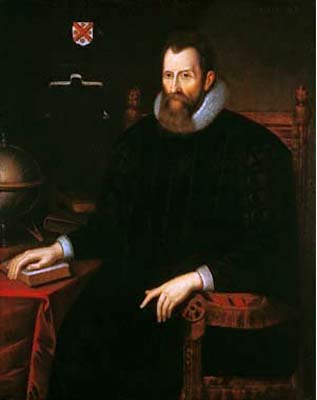
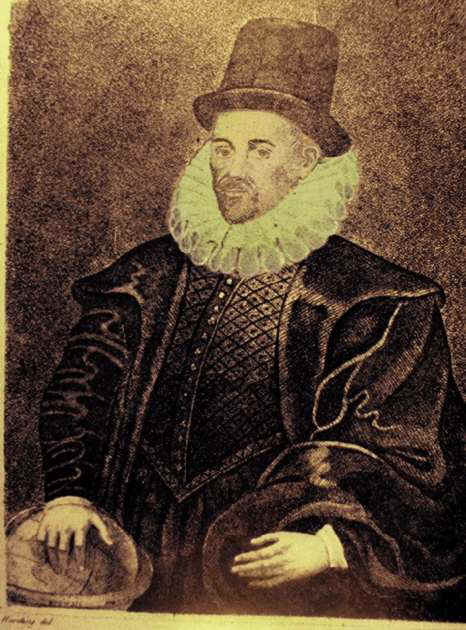
Gilbert is known for his investigations of magnetism and electricity. He is credited as one of the originators of the term electricity and many regard him as the founder of electrical engineering or electricity and magnetism.[1]
His primary work was De Magnete, Magneticisque Corporibus, et de Magno Magnete Tellure (On the Magnet and Magnetic Bodies, and on the Great Magnet the Earth) published in 1600. In this work, he describes many of his experiments with his model earth called the terrella. From these experiments, he concluded that the Earth was itself magnetic and that this was the reason compasses pointed north (previously, some believed that it was the pole star (Polaris) or a large magnetic island on the north pole that attracted the compass). He was the first to argue, correctly, that the centre of the Earth was iron, and he considered an important and related property of magnets was that they can be cut, each forming a new magnet with north and south poles.
The English word electricity was first used in 1646 by Sir Thomas Browne, derived from Gilbert's 1600 New Latin electricus, meaning "like amber". The term had been in use since the 1200s, but Gilbert was the first to use it to mean "like amber in its attractive properties". He recognized that friction with these objects removed a so-called effluvium, which would cause the attraction effect in returning to the object, though he did not realize that this substance (electric charge) was universal to all materials.[2]
The electric effluvia differ much from air, and as air is the earth's effluvium, so electric bodies have their own distinctive effluvia; and each peculiar effluvium has its own individual power of leading to union, its own movement to its origin, to its fount, and to the body emitting the effluvium.
—De Magnete, English translation by Paul Fleury Mottelay, 1893
In his book, he also studied static electricity using amber; amber is called elektron in Greek, so Gilbert decided to call its effect the electric force. He invented the first electrical measuring instrument, the electroscope, in the form of a pivoted needle he called the versorium.[3]
Like others of his day, he believed that "crystal" (quartz) was an especially hard form of water, formed from compressed ice:
Lucid gems are made of water; just as Crystal, which has been concreted from clear water, not always by a very great cold, as some used to judge, and by very hard frost, but sometimes by a less severe one, the nature of the soil fashioning it, the humour or juices being shut up in definite cavities, in the way in which spars are produced in mines.
—De Magnete, English translation by Silvanus Phillips Thompson, 1900
Gilbert argued that electricity and magnetism were not the same thing. For evidence, he (incorrectly) pointed out that, while electrical attraction disappeared with heat, magnetic attraction did not (although it is proven that magnetism does in fact become damaged and weakened with heat). It took James Clerk Maxwell to show that both effects were aspects of a single force: electromagnetism. Even then, Maxwell simply surmised this in his A Treatise on Electricity and Magnetism after much analysis. By keeping clarity, Gilbert's strong distinction advanced science for nearly 250 years.
Gilbert's magnetism was the invisible force that many other natural philosophers, such as Kepler, seized upon, incorrectly, as governing the motions that they observed. While not attributing magnetism to attraction among the stars, Gilbert pointed out the motion of the skies were due to earth's rotation, and not the rotation of the spheres, 20 years before Galileo.
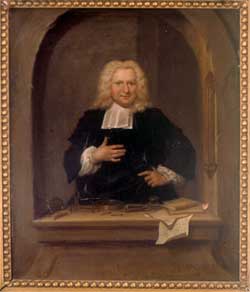
Van Musschenbroek attended Latin school until 1708, where he studied Greek, Latin, French, English, High German, Italian, and Spanish. He studied medicine at Leiden University and received his doctorate in 1718. He also attended lectures by John Theophilus Desaguliers and Isaac Newton in London. And in 1719, he finished his study in philosophy.
In 1719, he became professor of mathematics and philosophy in Duisburg. In 1721, he also became professor of medicine.
In 1723, he left his posts in Duisburg and became professor in Utrecht. In 1732 he also became professor in astrology.
Musschenbroek's Elementa Physica (1726) played an important part in the transmission of Isaac Newton's ideas in physics to Europe.
An early 20th century illustration of a Leyden jarIn 1739, he returned to Leiden, where he succeeded Willem 's Gravesande as professor.
Already during his studies at Leiden University Van Musschenbroek became interested in electrostatics. At that time, transient electrical energy could be generated by friction machines but there was no way to store it. Musschenbroek and his student Andreas Cunaeus discovered that the energy could be stored in a glass jar filled with water into which a brass rod had been placed; and that the energy could be released only by completing an external circuit between the brass rod and another conductor, originally his hand, placed in contact with the outside of the jar. He communicated this discovery to René Réaumur in January 1746, and it was Abbe Nollet, the translator of Musschenbroek's letter from Latin, who named the invention the 'Leyden jar'.
Soon afterwards, it transpired that a German scientist, Ewald von Kleist, had independently constructed a similar device in late 1745, shortly before Musschenbroek, but von Kleist failed to publicize his invention in time.
Van Musschenbroek died on 19 September 1761 in Leiden.
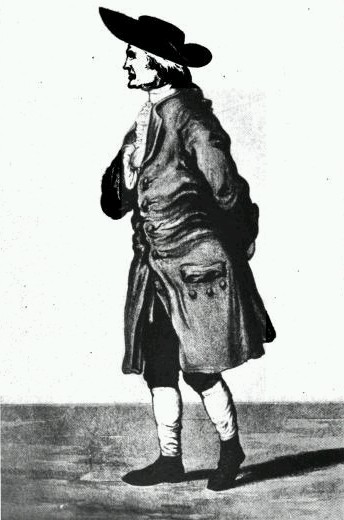
Personal life
Henry Cavendish was born on 10 October 1731 in Nice, France, where his family was living at the time. His mother was Lady Anne Grey, daughter of the Duke of Kent and his father was Lord Charles Cavendish, son of the second Duke. The family traces its lineage across eight centuries to Norman times and was closely connected to many aristocratic families of Great Britain.
At age 11, Cavendish was a pupil at Peter Newcome's School in Hackney. At age 18 (in 1749) he entered the University of Cambridge in St Peter's College, now known as Peterhouse, but left four years later without graduating. His first paper, "Factitious Airs", appeared thirteen years later, in 1766.
Cavendish was silent, and solitary, viewed as somewhat eccentric, and formed no close personal relationships outside his family. By one account, Cavendish had a back staircase added to his house in order to avoid encountering his housekeeper because he was especially shy of women. His only social outlet was the Royal Society Club, whose members dined together before weekly meetings. Cavendish seldom missed these meetings, and was profoundly respected by his contemporaries. However his shyness made those who "sought his views... speak as if into vacancy. If their remarks were...worthy, they might receive a mumbled reply." He also enjoyed collecting fine furniture exemplified by his purchase of a set of "ten inlaid satinwood chairs with matching cabriole legged sofa" documented to have been acquired by Cavendish himself.
Because of his asocial and secretive behavior, Cavendish often avoided publishing his work, and much of his findings were not even told to his fellow scientists. It wasn't until the late nineteenth century, long after his death, that James Clerk Maxwell looked through Cavendish's papers and found things for which others had been given credit. Examples of what was included in Cavendish's discoveries or anticipations were Richter's Law of Reciprocal Proportions, Ohm's Law, Dalton's Law of Partial Pressures, principles of electrical conductivity (including Coulomb's Law), and Charles's Law of Gases.
Cavendish died in 1810 and was buried in the church that is now Derby Cathedral, along with many of his ancestors. The University of Cambridge's Cavendish Laboratory was endowed by one of Cavendish's later relatives, William Cavendish, 7th Duke (Chancellor of the University from 1861 to 1891).
Gases and the atmosphere
Cavendish's apparatus for making and collecting hydrogen[1]Cavendish is considered to be one of the so-called pneumatic chemists of the eighteenth and nineteenth centuries, along with, for example, Joseph Priestley, Joseph Black, and Daniel Rutherford. By combining metals with strong acids, Cavendish made hydrogen (H2) gas, which he isolated and studied. Although others, such as Robert Boyle, had prepared hydrogen gas earlier, Cavendish is usually given the credit for recognizing its elemental nature.
Cavendish observed that hydrogen, which he called "inflammable air", reacts with oxygen, then known as "dephlogisticated air", to form water. James Watt and Antoine Lavoisier made a similar observation, resulting in a controversy as to who should receive credit for it.
Cavendish also accurately determined the composition of Earth's atmosphere. He found that 79.167% is "phlogisticated air", now known to be nitrogen and argon, and 20.8333% is "dephlogisticated air", now known to be 20.95% oxygen. Cavendish also found that 1/120 of the Earth's atmosphere is a third gas, which was identified as argon about 100 years later by William Ramsay and Lord Rayleigh.
Density of the Earth
Main article: Cavendish experiment
Artist's rendition of Cavendish conducting his experiment with the torsion balance. In addition to his achievements in chemistry, Cavendish is also known for the Cavendish experiment, the first to measure the force of gravity between masses in a laboratory and to produce an accurate value for the Earth's density. His work led others to accurate values for the gravitational constant (G) and the Earth's mass.
The apparatus was sent in crates to Cavendish, who completed the experiment in 1797 – 1798 and published the results.[4]
The experimental apparatus consisted of a torsion balance to measure the gravitational attraction between two 350-pound lead spheres and a pair of 2-inch 1.61-pound lead spheres. Using this equipment, Cavendish found that the Earth's average density is 5.48 times greater than that of water. Poynting later noted that the data should have led to a value of 5.448, and indeed that is the average value of the twenty-nine determinations Cavendish included in his paper.
It is not unusual to find books that erroneously describe Cavendish's work as a measurement either of the gravitational constant (G) or the Earth's mass, and this mistake has been pointed out by several authors.[9][10] In reality, Cavendish's stated goal was to measure the Earth's density, and his result was later used to calculate G. The first time that this constant was used was in 1873, almost 100 years after the Cavendish experiment. Cavendish's results also can be used to calculate the Earth’s mass.
Cavendish performed his experiment in an outbuilding in the garden of his Clapham Commons estate. For years afterward, his neighbors would point out the building and tell their children that it was where the world was weighed.
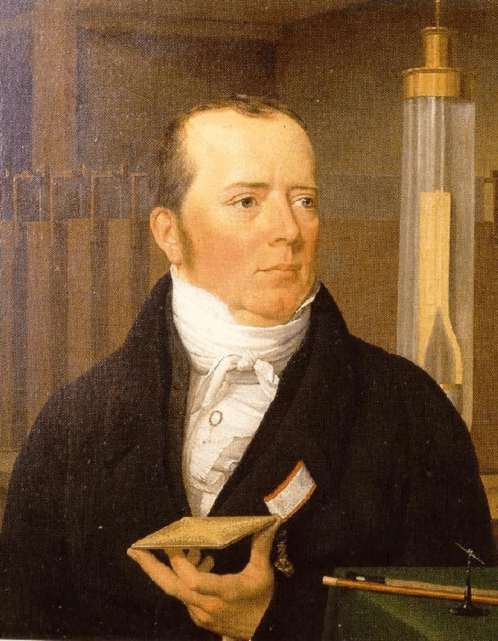
Early life and studies
Ørsted developed his interest in science while working as a young boy for his father, Søren Christian Ørsted, who owned a pharmacy. He and his brother, Anders Sandøe Ørsted, received most of their early education through self-study at home, leaving home for Copenhagen in 1793 to take entrance exams for the University of Copenhagen. The brothers passed and distinguished themselves academically at the University. By 1796, Ørsted received honours for his papers in both aesthetics and physics.
In 1801, Hans received a travel scholarship and public grant that enabled him to spend three years traveling in Europe. In Germany, he met Johann Wilhelm Ritter, a physicist who believed there was a connection between electricity and magnetism. The connection made sense to Ørsted since he believed in the unity of nature, and, therefore, that a relationship must exist between most natural phenomena.
Their conversations drew Ørsted into the study of physics. He became a professor at the University of Copenhagen in 1806 and continued his research with electric currents and acoustics. Under his guidance, the University developed a comprehensive physics and chemistry program and established new laboratories.
Electromagnetism
Statue of Ørsted in Ørstedsparken, in Copenhagen While preparing for an evening lecture on 21 April 1820, Ørsted developed an experiment which provided evidence that surprised him. As he was setting up his materials, he noticed a compass needle deflected from magnetic north when the electric current from the battery he was using was switched on and off. This deflection convinced him that magnetic fields radiate from all sides of a wire carrying an electric current, just as light and heat do, and that it confirmed a direct relationship between electricity and magnetism.
At the time of discovery, Ørsted did not suggest any satisfactory explanation of the phenomenon, nor did he try to represent the phenomenon in a mathematical framework. However, three months later he began more intensive investigations. Soon thereafter he published his findings, proving that an electric current produces a magnetic field as it flows through a wire. The CGS unit of magnetic induction (oersted) is named in honor of his contributions to the field of electromagnetism.
His findings resulted in intensive research throughout the scientific community in electrodynamics. The findings influenced French physicist André-Marie Ampère's developments of a single mathematical form to represent the magnetic forces between current-carrying conductors. Ørsted's discovery also represented a major step toward a unified concept of energy.
Aluminium
In 1825, Ørsted made a significant contribution to chemistry by producing aluminium for the first time.
Death and legacy
100 danske kroner − Danish banknote from 1970 featuring ØrstedØrsted died in 1851, and was buried in the Asitens Cemetery in Copenhagen.
The 100 danske kroner note issued from 1950 to 1970 features an engraving of Ørsted.
Today, the buildings which are home to the Department of Chemistry and the Institute for Mathematical Sciences at the University of Copenhagen, are named The H.C. Ørsted Institute in his honor. Also, the first Danish satellite, launched 1999, was named Ørsted in his honor.
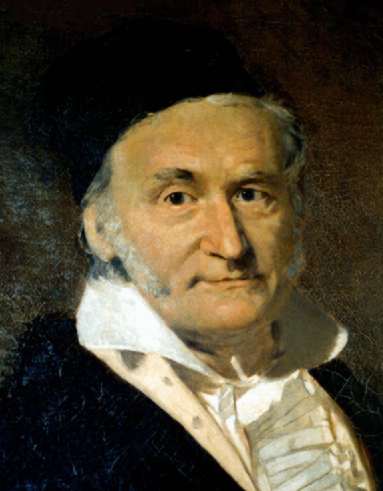
Gauss was a child prodigy. There are many anecdotes pertaining to his precocity while a toddler, and he made his first ground-breaking mathematical discoveries while still a teenager. He completed Disquisitiones Arithmeticae, his magnum opus, in 1798 at the age of 21, though it would not be published until 1801. This work was fundamental in consolidating number theory as a discipline and has shaped the field to the present day.
Early years (1777–1798)
Statue of Gauss in his birthplace of BraunschweigCarl Friedrich Gauss was born in Braunschweig, in the Electorate of Brunswick-Lüneburg, now part of Lower Saxony, Germany, as the only son of poor working-class parents. There are several stories of his early genius. According to one, his gifts became very apparent at the age of three when he corrected, mentally and without fault in his calculations, an error his father had made on paper while calculating finances.
Another famous story, and one that has evolved in the telling, has it that in primary school his teacher, J.G. Büttner, tried to occupy pupils by making them add a list of integers. The young Gauss reputedly produced the correct answer within seconds, to the astonishment of his teacher and his assistant Martin Bartels. Gauss's presumed method, which supposes the list of numbers was from 1 to 100, was to realise that pairwise addition of terms from opposite ends of the list yielded identical intermediate sums: 1 + 100 = 101, 2 + 99 = 101, 3 + 98 = 101, and so on, for a total sum of 50 × 101 = 5050 (see arithmetic series and summation).[5] However whilst the method works, the incident itself is probably apocryphal; some, such as Joseph Rotman in his book A first course in Abstract Algebra, question whether it ever happened.
As his father wanted him to follow in his footsteps and become a mason, he was not supportive of Gauss's schooling in mathematics and science. Gauss was primarily supported by his mother in this effort and by the Duke of Braunschweig, who awarded Gauss a fellowship to the Collegium Carolinum (now Technische Universität Braunschweig), which he attended from 1792 to 1795, and subsequently he moved to the University of Göttingen from 1795 to 1798. While in university, Gauss independently rediscovered several important theorems;[citation needed] his breakthrough occurred in 1796 when he was able to show that any regular polygon with a number of sides which is a Fermat prime (and, consequently, those polygons with any number of sides which is the product of distinct Fermat primes and a power of 2) can be constructed by compass and straightedge. This was a major discovery in an important field of mathematics; construction problems had occupied mathematicians since the days of the Ancient Greeks, and the discovery ultimately led Gauss to choose mathematics instead of philology as a career. Gauss was so pleased by this result that he requested that a regular heptadecagon be inscribed on his tombstone. The stonemason declined, stating that the difficult construction would essentially look like a circle.[citation needed]
The year 1796 was most productive for both Gauss and number theory. He discovered a construction of the heptadecagon on March 30.[6] He invented modular arithmetic, greatly simplifying manipulations in number theory.[citation needed] He became the first to prove the quadratic reciprocity law on April 8. This remarkably general law allows mathematicians to determine the solvability of any quadratic equation in modular arithmetic. The prime number theorem, conjectured on May 31, gives a good understanding of how the prime numbers are distributed among the integers. Gauss also discovered that every positive integer is representable as a sum of at most three triangular numbers on July 10 and then jotted down in his diary the famous words, "Heureka! num = Δ + Δ + Δ." On October 1 he published a result on the number of solutions of polynomials with coefficients in finite fields, which ultimately led to the Weil conjectures 150 years later.
Middle years (1799–1830)
In his 1799 doctorate in absentia, A new proof of the theorem that every integral rational algebraic function of one variable can be resolved into real factors of the first or second degree, Gauss proved the fundamental theorem of algebra which states that every non-constant single-variable polynomial over the complex numbers has at least one root. Mathematicians including Jean le Rond d'Alembert had produced false proofs before him, and Gauss's dissertation contains a critique of d'Alembert's work. Ironically, by today's standard, Gauss's own attempt is not acceptable, owing to implicit use of the Jordan curve theorem. However, he subsequently produced three other proofs, the last one in 1849 being generally considered rigorous. His attempts clarified the concept of complex numbers considerably along the way.
Gauss also made important contributions to number theory with his 1801 book Disquisitiones Arithmeticae (Latin, Arithmetical Investigations), which contained a clean presentation of modular arithmetic and the first proof of the law of quadratic reciprocity.
Title page of Gauss's Disquisitiones ArithmeticaeIn that same year, Italian astronomer Giuseppe Piazzi discovered the dwarf planet Ceres, but could only watch it for a few days. Gauss predicted correctly the position at which it could be found again, and it was rediscovered by Franz Xaver von Zach on December 31, 1801 in Gotha, and one day later by Heinrich Olbers in Bremen. Zach noted that "without the intelligent work and calculations of Doctor Gauss we might not have found Ceres again." Though Gauss had been up to that point supported by the stipend from the Duke, he doubted the security of this arrangement, and also did not believe pure mathematics to be important enough to deserve support. Thus he sought a position in astronomy, and in 1807 was appointed Professor of Astronomy and Director of the astronomical observatory in Göttingen, a post he held for the remainder of his life.
The discovery of Ceres by Piazzi on January 1, 1801 led Gauss to his work on a theory of the motion of planetoids disturbed by large planets, eventually published in 1809 under the name Theoria motus corporum coelestium in sectionibus conicis solem ambientum (theory of motion of the celestial bodies moving in conic sections around the sun). Piazzi had only been able to track Ceres for a couple of months, following it for three degrees across the night sky. Then it disappeared temporarily behind the glare of the Sun. Several months later, when Ceres should have reappeared, Piazzi could not locate it: the mathematical tools of the time were not able to extrapolate a position from such a scant amount of data—three degrees represent less than 1% of the total orbit.
Gauss, who was 23 at the time, heard about the problem and tackled it. After three months of intense work, he predicted a position for Ceres in December 1801—- just about a year after its first sighting—and this turned out to be accurate within a half-degree. In the process, he so streamlined the cumbersome mathematics of 18th century orbital prediction that his work—- published a few years later as Theory of Celestial Movement—- remains a cornerstone of astronomical computation.[citation needed] It introduced the Gaussian gravitational constant, and contained an influential treatment of the method of least squares, a procedure used in all sciences to this day to minimize the impact of measurement error. Gauss was able to prove the method in 1809 under the assumption of normally distributed errors (see Gauss–Markov theorem; see also Gaussian). The method had been described earlier by Adrien-Marie Legendre in 1805, but Gauss claimed that he had been using it since 1795.
Gauss' portrait published in Astronomische Nachrichten 1828Gauss was a prodigious mental calculator. Reputedly, when asked how he had been able to predict the trajectory of Ceres with such accuracy he replied, "I used logarithms." The questioner then wanted to know how he had been able to look up so many numbers from the tables so quickly. "Look them up?" Gauss responded. "Who needs to look them up? I just calculate them in my head!"
In 1818 Gauss, putting his calculation skills to practical use, carried out a geodesic survey of the state of Hanover, linking up with previous Danish surveys. To aid in the survey, Gauss invented the heliotrope, an instrument that uses a mirror to reflect sunlight over great distances, to measure positions.
Gauss also claimed to have discovered the possibility of non-Euclidean geometries but never published it. This discovery was a major paradigm shift in mathematics, as it freed mathematicians from the mistaken belief that Euclid's axioms were the only way to make geometry consistent and non-contradictory. Research on these geometries led to, among other things, Einstein's theory of general relativity, which describes the universe as non-Euclidean. His friend Farkas Wolfgang Bolyai with whom Gauss had sworn "brotherhood and the banner of truth" as a student had tried in vain for many years to prove the parallel postulate from Euclid's other axioms of geometry. Bolyai's son, János Bolyai, discovered non-Euclidean geometry in 1829; his work was published in 1832. After seeing it, Gauss wrote to Farkas Bolyai: "To praise it would amount to praising myself. For the entire content of the work... coincides almost exactly with my own meditations which have occupied my mind for the past thirty or thirty-five years."
Four Gaussian distributions in statisticsThis unproved statement put a strain on his relationship with János Bolyai (who thought that Gauss was "stealing" his idea), but it is now generally taken at face value.[citation needed] Letters by Gauss years before 1829 reveal him obscurely discussing the problem of parallel lines. Waldo Dunnington, a life-long student of Gauss, successfully proves in Gauss, Titan of Science that Gauss was in fact in full possession of non-Euclidian geometry long before it was published by János, but that he refused to publish any of it because of his fear of controversy.
The survey of Hanover fueled Gauss's interest in differential geometry, a field of mathematics dealing with curves and surfaces. This led in 1828 to an important theorem, the Theorema Egregium (remarkable theorem in Latin), establishing an important property of the notion of curvature. Informally, the theorem says that the curvature of a surface can be determined entirely by measuring angles and distances on the surface. That is, curvature does not depend on how the surface might be embedded in 3-dimensional space.
Later years and death (1831–1855)
Grave of Gauss at AlbanifriedhofIn 1831 Gauss developed a fruitful collaboration with the physics professor Wilhelm Weber, leading to new knowledge in magnetism (including finding a representation for the unit of magnetism in terms of mass, length and time) and the discovery of Kirchhoff's circuit laws in electricity. They constructed the first electromagnetic telegraph in 1833, which connected the observatory with the institute for physics in Göttingen. Gauss ordered a magnetic observatory to be built in the garden of the observatory, and with Weber founded the magnetischer Verein (magnetic club in German), which supported measurements of earth's magnetic field in many regions of the world. He developed a method of measuring the horizontal intensity of the magnetic field which has been in use well into the second half of the 20th century and worked out the mathematical theory for separating the inner (core and crust) and outer (magnetospheric) sources of Earth's magnetic field.
Gauss died in Göttingen, Hannover (now part of Lower Saxony, Germany) in 1855 and is interred in the cemetery Albanifriedhof there. Two individuals gave eulogies at his funeral, Gauss's son-in-law Heinrich Ewald and Wolfgang Sartorius von Waltershausen, who was Gauss's close friend and biographer. His brain was preserved and was studied by Rudolf Wagner who found its weight to be 1,492 grams and the cerebral area equal to 219,588 square millimeters[7] (340.362 square inches). Highly developed convolutions were also found, which in the early 20th century was suggested as the explanation of his genius.
Family
Gauss's personal life was overshadowed by the early death of his first wife, Johanna Osthoff, in 1809, soon followed by the death of one child, Louis. Gauss plunged into a depression from which he never fully recovered. He married again, to Johanna's best friend named Friederica Wilhelmine Waldeck but commonly known as Minna. When his second wife died in 1831 after a long illness,[9] one of his daughters, Therese, took over the household and cared for Gauss until the end of his life. His mother lived in his house from 1817 until her death in 1839.
Gauss had six children. With Johanna (1780–1809), his children were Joseph (1806–1873), Wilhelmina (1808–1846) and Louis (1809–1810). Of all of Gauss's children, Wilhelmina was said to have come closest to his talent, but she died young. With Minna Waldeck he also had three children: Eugene (1811–1896), Wilhelm (1813–1879) and Therese (1816–1864). Eugene emigrated to the United States about 1832 after a falling out with his father.[citation needed] Wilhelm also settled in Missouri, starting as a farmer and later becoming wealthy in the shoe business in St. Louis. Therese kept house for Gauss until his death, after which she married.
Gauss eventually had conflicts with his sons, two of whom migrated to the United States. He did not want any of his sons to enter mathematics or science for "fear of sullying the family name".[citation needed] Gauss wanted Eugene to become a lawyer, but Eugene wanted to study languages. They had an argument over a party Eugene held, which Gauss refused to pay for. The son left in anger and emigrated to the United States, where he was quite successful. It took many years for Eugene's success to counteract his reputation among Gauss's friends and colleagues. See also the letter from Robert Gauss to Felix Klein on September 3, 1912.